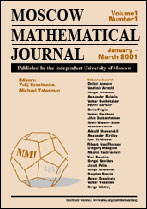|
This article is cited in 28 scientific papers (total in 28 papers)
A large-deviation view on dynamical Gibbs–non-Gibbs transitions
A. C. D. van Entera, R. Fernándezb, F. den Hollanderc, F. Redigd
a Johann Bernoulli Institute of Mathematics and Computer Science, University of Groningen, Groningen, The Netherlands
b Department of Mathematics, Utrecht University, Utrecht, The Netherlands
c Mathematical Institute, Leiden University, Leiden, The Netherlands
d IMAPP, Radboud University Nijmegen, Nijmegen, The Netherlands
Abstract:
We develop a space-time large-deviation point of view on Gibbs–non-Gibbs transitions in spin systems subject to a stochastic spin-flip dynamics. Using the general theory for large deviations of functionals of Markov processes outlined in a recent book by Feng and Kurtz, we show that the trajectory under the spin-flip dynamics of the empirical measure of the spins in a large block in $\mathbb Z^d$ satisfies a large deviation principle in the limit as the block size tends to infinity. The associated rate function can be computed as the action functional of a Lagrangian that is the Legendre transform of a certain non-linear generator, playing a role analogous to the moment-generating function in the Gärtner–Ellis theorem of large deviation theory when this is applied to finite-dimensional Markov processes. This rate function is used to define the notion of “bad empirical measures”, which are the discontinuity points of the optimal trajectories (i.e., the trajectories minimizing the rate function) given the empirical measure at the end of the trajectory. The dynamical Gibbs–non-Gibbs transitions are linked to the occurrence of bad empirical measures: for short times no bad empirical measures occur, while for intermediate and large times bad empirical measures are possible. A future research program is proposed to classify the various possible scenarios behind this crossover, which we refer to as a “nature-versus-nurture” transition.
Key words and phrases:
stochastic spin-flip dynamics, Gibbs–non-Gibbs transition, empirical measure, non-linear generator, Nisio control semigroup, large deviation principle, bad configurations, bad empirical measures, nature versus nurture.
Received: May 1, 2010; in revised form July 5, 2010
Citation:
A. C. D. van Enter, R. Fernández, F. den Hollander, F. Redig, “A large-deviation view on dynamical Gibbs–non-Gibbs transitions”, Mosc. Math. J., 10:4 (2010), 687–711
Linking options:
https://www.mathnet.ru/eng/mmj399 https://www.mathnet.ru/eng/mmj/v10/i4/p687
|

| Statistics & downloads: |
| Abstract page: | 380 | | References: | 82 |
|




 Contact us:
Contact us: Terms of Use
Terms of Use
 Registration to the website
Registration to the website Logotypes
Logotypes








 Citation in format
Citation in format 
